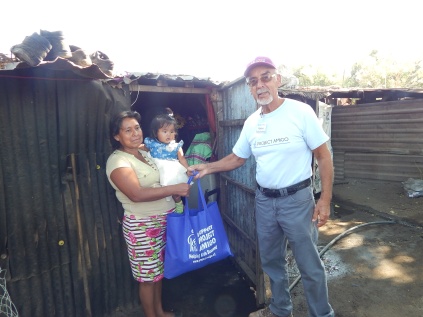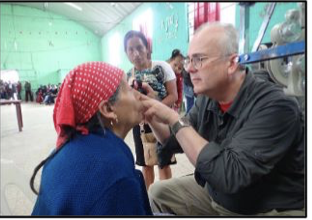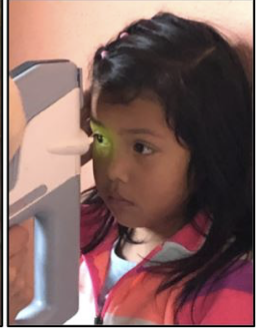After spending a week volunteering at Project Amigo with several Past District Governors and their spouses, Jim Ferguson (Rotary E-club of Canada One) feels he knows these former District 5370 leaders much better than before.

Jim Ferguson with kindergarten-aged soccer players
“I hadn’t had much interaction with Past District Governors. I had seen them at District events but only knew them to say hi,” says Jim, who will serve as District 5370 governor in 2020-2021. “I thought of them as Rotary royalty for what they have accomplished in our District.”
“When you get together and actually have a chance to get to know them personally, it was a fantastic experience,” Jim says. “The PDGs are a great group of people.”
The idea of a workweek for District Governors has been percolating for several years, according to PDG Elly Contreras (Rotary E-club of Canada One), who now serves as Canadian Intermediary for the Project Amigo Canada Society (PACS).
“My wish was to have more Rotarians, particularly my fellow governors, participate,” she says. “Several expressed interest, but it just didn’t happen.”
Plans made at District Conference in Fort McMurray
That is, nothing happened until the 2017 District Conference in Fort McMurray.
“At the conference, there was discussion about why more clubs didn’t participate in Project Amigo,” says Frank Reitz (RC of Fort McMurray), who was District Governor at the time. “We talked about it, which led to us deciding to schedule a workweek for past District Governors.”
In addition to Jim and his wife Jocelyn, the team that went to Cofradia, Mexico, in mid-February, included DGE Tracey Vavrek and her husband Vince, and seven PDGs and their spouses—Judy Brown (Ron), Elly Contreras (Ramiro), Terry Drader (Mary), Ross Tyson (Brenda), Jackie Hobal (Wayne), Betty Screpnek (George), and Frank Reitz (Barbara).
Elly, who has been visiting Project Amigo since 2008 organized the visit by the past and future District Governors.
“I found right from the very moment we arrived that the week was very well-organized and action-packed. Elly had us on the move from morning to night,” Jim says.
“They were surprised by the wonderful accommodation with private bathrooms, the wonderful meals every day, the various activities planned for them, and most of all by the amazing structures Project Amigo has developed over the last 35 years,” Elly says.
PDG Judy Brown (Rotary E-club of Canada One) has an even longer history with Project Amigo than Elly as a longtime volunteer and as a member of the PACS board.
“I first heard about Project Amigo when Ted Rose and Susan Hill came to Edmonton and did a presentation for our Rotary club (Edmonton Riverview),” Judy says. “My late husband, Peter, and I spent our winter vacations in Manzanillo, which is only about one and half hours away from where Project Amigo is headquartered.”
“The next year, we visited with Ted and Susan at Project Amigo. Ted took us around the area to show us what they were doing. Peter and I went back pretty well every year from 2002 to 2010.”
“My husband, Ron Brown, and I have attended three workweeks since 2012,” Judy says. “We keep coming back because we are hooked on this great initiative—seeing first-hand what a difference we are making by enabling children to go to school.”
“For nearly 20 years, Rotarians from our District have participated in workweeks at Project Amigo during the winter months,” Elly says.
Click here to learn how you can be part of a future Project Amigo workweek.
Each of the governors had his or her own reason for volunteering for this workweek. For Jim, it was an opportunity to be part of a service project in another country.
“I haven’t been on an overseas service project before and this was a chance to participate in one,” Jim says, who also had a more personal connection to Project Amigo.
“Our E-club has a student we are supporting through Project Amigo, so I knew I would have a chance to meet her.”
Clubs and individuals can sponsor Project Amigo students: $135 a year for an elementary student, $795 for a secondary student and $5,280 for a post-secondary student (including accommodation at Casa Amigo). In addition, there are other non-sponsorship ways to support Project Amigo.
PDG Ross Tyson (RC of Edmonton Northeast) felt that volunteering with other past governors would be something special.
“We had talked about it for a long time and planned for the workweek for about a year,” he says. “The fellowship you gain from going with people you know is second to none because you spend 16 hours a day together.”
“I was pleasantly surprised by what the people with Project Amigo do,” Ross says. “I only thought about sponsoring students. I had not expected to see children mentoring each other in the homework club. After school, the older sponsored kids nurture and coach younger sponsored kids.”
Ross notes that to remain in the Project Amigo program the students must keep up with their studies.
“They are required to maintain a certain average to stay in the program,” he says. “This is a sustainable aspect of Project Amigo, because it helps ensure that the sponsors’ money is well spent.”
The team spent its days visiting schools, meeting students and their parents, and becoming involved in activities with the children.
“We were able to feel the positive impact of Project Amigo when we met the kids and their parents. These kids are having a positive experience—the opportunity for a better life,” says Frank

DGE Tracey Vavrek reads with a Project Amigo student
“We met children who only experienced going to school (with) books and crayons because of the direct participant of Project Amigo and their supporters,” says DGE Tracey (RC of Grande Prairie After Five).
“We met teenagers who are advancing and actively participating in their schooling due to the financial support and gifts of tools like computers and books. We met young people who were on the road to becoming lawyers, nurses, hairstylists and more, because someone invested time and resources in them, believing in them,” she says.
Each team member brought an extra suitcase filled with colouring books, crayons, toothbrushes, clothing and other supplies, which they distributed to students at Project Amigo and to the children at a nearby camp for migrant workers.
The migrant workers bring their families with them when they come from other parts of

Ramiro Contreras delivers a bag of food to a family in the migrant camp
Mexico to work in sugar cane fields. At the camp, the team “witnessed poverty at a level I could only imagine,” says Tracey. “We saw homes that were small concrete facilities with dirt floors, with access to water in a common area outside of the homes. This area was used for dishwashing and washing clothes.”
“This was an opportunity to experience a lifestyle that was so different than ours,” Frank says. “Inmates at the Edmonton Remand Centre have it better than these families.”
Beside working with the children, the workweek was an opportunity to experience the culture of Mexico.
They learned to make salsa and guacamole, joined a meeting of the Rotary Club of Coquimatlan, visited the La Campana archeological site, and toured a mescal distillery.
The team even helped Frank and Barbara celebrate their 51st wedding anniversary.
For all the District Governors, past and future, the Project Amigo was a special experience.
“It did bring us together in a way we weren’t before. We are a family of past governors, but thought the workweek, we came together in our understanding of the values of Rotary and the potential of Rotary,” Frank says.
“The level of interaction was different than in the past. We all experienced something that was really amazing and that only comes from participation in a common experience,” he says.
“It was so great to share Project Amigo with our Rotary colleagues, to see the emotion they felt when interacting with the beautiful children that we are helping,” says Judy. “We experienced wonderful Rotary fellowship and got to know everyone better than before. It was truly an amazing week, never to be forgotten.”

 “During any international projects, there are those moments when you see instantly the difference you are making to the lives of the people you are helping,” says club president Annie Mueller. “There are also the heartbreaking moments when you realize there is nothing you can do.”
“During any international projects, there are those moments when you see instantly the difference you are making to the lives of the people you are helping,” says club president Annie Mueller. “There are also the heartbreaking moments when you realize there is nothing you can do.” “They pick the clinic locations, ensuring that they are the most needy and have the facilities we need,” says Edmonton optometrist and Rotarian Benjamin Doz, who led the team from Edmonton West. “They handle the advertising, translators, volunteers and transportation. In addition, they arrange billets and ensure the visiting teams are kept healthy and safe.”
“They pick the clinic locations, ensuring that they are the most needy and have the facilities we need,” says Edmonton optometrist and Rotarian Benjamin Doz, who led the team from Edmonton West. “They handle the advertising, translators, volunteers and transportation. In addition, they arrange billets and ensure the visiting teams are kept healthy and safe.” A total of 841 patients were seen in clinics held in three communities during the week-long mission.
A total of 841 patients were seen in clinics held in three communities during the week-long mission. After three days in La Liberta, the team returned to Huehuetenago, where they attended
After three days in La Liberta, the team returned to Huehuetenago, where they attended When asked about District 5370 membership numbers, the District membership committee chair responds with just two words: “Extremely volatile!”
When asked about District 5370 membership numbers, the District membership committee chair responds with just two words: “Extremely volatile!”